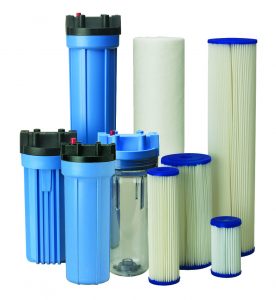Water filters come in different types and sizes to address various types of potential water quality issues experienced in North Grafton, Mass. There are cartridge style water filters and whole house water filters which will be reviewed in the balance of this write-up. Matching the right technology and sizing the system to meet the water usage demands are paramount. Additionally, a professionally plumbed system is paramount as well as maintenance of the system throughout the years. This will optimize the useful life and proper functioning of your new water filtration equipment.
CARTRIDGE STYLE WATER FILTER
There are various types and sizes of water filter cartridges with differentiating features relating to what you are trying to mechanically remove from the water. These filters do not work on removing dissolved impurities from the water as other technologies must be used for this purpose.
SEDIMENT WATER FILTER CARTRIDGES
As their name implies, are for removing sediment (particulate matter) from the water supply. Key characteristics relate to the micron rating of the filter designed to remove particles at or greater than a specified size. Also to be considered is the capacity or how long the filter will work before needing replacement. Specifying a micron rating that is too small may cause an unacceptable drop in water pressure. Specifying a micron rating that is not small enough may produce less than optimal results .
Sediment filter are important because sediment can be abrasive to all of your water using appliances. Additionally, it can negatively affect other types of water filtration or water softening equipment that you may have installed. Removing sediment is also a good first step in providing better drinking water.. For more on high quality drinking water, see the link at http:/reverse-osmosis/.
CARBON WATER FILTER CARTRIDGES
These filters use activated carbon to remove chemicals (such as chlorine, volatile organics and others) and some bad tastes and odors from water. Carbon filters are also components of reverse osmosis purification systems to remove chlorine from water prior to flowing to the systems’ membrane which can be negatively affected by the chlorine. Water passes through activated carbon, which is porous, trapping certain particles that are attracted to the porous material in a process called adsorption. At some point, adsorption capacity is exceeded and the filter must be changed. As with sediment water filters, the micron rating and size of the filter must be matched to the specific situation.
POINT OF ENTRY, WHOLE HOUSE WATER FILTERS
WATER SOFTENERS

High Efficiency Water Softener
Water softeners are designed for removing hard water minerals (magnesium & calcium) as well as dissolved iron and manganese. For water with high levels of iron or manganese, an “up-flow” water softener is recommended. This will help prevent mineral build-up in the bottom of the water softener. Also, high efficiency water softeners that are more efficient with both water and salt usage are preferred.
POINT OF ENTRY, WHOLE HOUSE FILTERS
For higher volume water usage, the use of cartridge filters may not make sense. On the other hand, A high capacity point of entry system may be the solution. These systems do not require the frequency of change-outs that cartridge filters do. They also have the ability to automatically clean themselves, extending the life of the media inside the tank. Another example would be if your town supplied water is high in chlorine and you wish to eliminate it from your water supply. A point of entry carbon water filter will have enough capacity to last much longer and also remove more of the chlorine due to longer “contact time”.
BAD TASTES & ODORS, SEDIMENT

In addition to the above systems, there are many other types of systems to remove bad tastes & odors, sediment and many other objectionable minerals and contaminants in the water. Starting with a water test will dictate the right approach. For more information on common bad odors & tastes in New England water supplies, see the link at http://bad-odor-taste.





